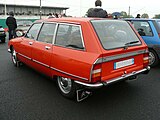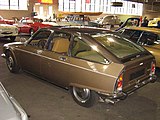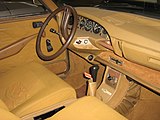Citroën GS
| Citroën | |
|---|---|
|
Citroën GS (1970–1979)
|
|
| GS / GSA | |
| Production period: | 1970-1986 |
| Class : | Lower middle class |
| Body versions : | Sedan , hatchback , station wagon |
| Engines: |
Otto engines : 1.0-1.3 liters (40-48 kW) Wankel engine : 1.0 liters (79 kW) |
| Length: | 4120-4180 mm |
| Width: | 1600-1620 mm |
| Height: | 1350 mm |
| Wheelbase : | 2550 mm |
| Empty weight : | 880-965 kg |
| successor | Citroën BX |
The Citroën GS (“Grande Série”, German for “large model series”), later GSA , is a passenger car model of the French car manufacturer Citroën , 2.5 million units were produced between autumn 1970 and mid-1986. Most of them rolled off the assembly line at the Rennes plant .
From October 1970 to August 1979 the vehicle was known as the GS , to which a station wagon called the Break was added in September 1971 . After a revision in September 1979, the series was called GSA ("Grande Série athlète"), in which the hatchback sedan got a wide-opening flap.
The GS had front-wheel drive and four - cylinder boxer engines with air cooling . Its hydraulic system, the hydropneumatics , was derived in a simplified form from its larger sister model, the Citroën DS ; in the GS, for example, there was no power steering .
The body , which was unusually aerodynamic for the time, enabled low fuel consumption and an above-average speed. The engines , which were quiet despite air cooling and high speeds, and the large interior made it a comfortable car.
drive
Engines
The air-cooled four-cylinder boxer engine was redesigned and had two overhead camshafts , each driven by a toothed belt , which operated the valves via rocker arms. It was initially offered with 1015 cm³ displacement and 54 PS (40 kW) at 6500 / min and a maximum torque of 72 Nm at 3500 / min, later also with 1129 cm³ and 55 PS (40 kW), 1220 cm³ with 58 PS ( 43 kW) and 63 PS (46 kW). In the last year of construction, the 1299 cm³ engine with 65 HP (48 kW) intended for the GSA was already available in some countries.
The further developed GSA was powered by engines with 1129 cm³ and 57 HP (42 kW) or 1299 cm³ with 65 HP (48 kW). The latter was available in two versions, which differed primarily in terms of transistor ignition and consumption.
Birotor
Between September 1973 and October 1975 there was a model with a twin-disc rotary engine from Comotor called Birotor with 107 hp (79 kW) at 6500 rpm and a maximum torque of 137 Nm at 3000 rpm. Comotor was a joint venture between Citroën and NSU . The Wankel engine used in the GS had the type designation KKM 624 and was a further development of the KKM 612 from the Ro 80 , although the geometry of the Ro80 engine was retained (e.g. eccentricity, chamber volume, rotor width). One of the development goals for the KKM 624 was a reduced size to fit in the engine compartment of the GS. Compared to the KKM 612 of the Ro80, the flow of cooling water through the motor was now in the direction of the eccentric shaft, which promised to improve the motor cooling. Add-on parts were also repositioned on the engine in order to reduce the construction volume. Despite the same motor parameters, the motors of the Birotor and Ro80 cannot be regarded as identical. It also had a Bosch transistor ignition, a Solex double carburetor type 32 DDITS and an early device for exhaust gas purification (air injection into the exhaust gas flow via a pump driven by V-belt and a so-called exhaust gas reactor). As with the Ro80, a three-speed semi-automatic transmission transferred the power, but with a torque converter from the manufacturer Borg-Warner. The Comotor rotary engine was still used in the Van Veen OCR 1000 . VW withdrew from the contract concluded by NSU and Citroën in 1972 and Comotor became the sole subsidiary of Citroën. A total of 847 GS Birotor were produced.
Citroën later tried to buy back all GS Birotor in order not to have to maintain a supply of spare parts ; only a small, unknown number escaped direct scrapping.
Transmission and chassis
The GS had a four-speed gearbox as standard, and a three-speed semi-automatic with torque converter clutch was available for an extra charge. The Birotor had a three-speed semi-automatic as standard, a similar transmission was later found as an option on the Citroën CX .
The GSA had a four- or five-speed gearbox depending on the equipment variant and engine. The five-speed transmissions either had a rather short, sporty or a more comfort-emphasizing overall gear ratio, because the engine speed was reduced. The three-speed semi-automatic transmission, which is already known from the GS, was translated much longer and provided with the parking lock that is common with automatic transmissions.
The front wheels of all GS variants were suspended from double wishbones, and there were longitudinal swing arms at the rear. The steering worked with a pinion and rack. The jamming force lever arm was zero and the front disc brakes were on the inside, that is, they were on the transmission output shafts and not on the wheels.
The main feature of the models, however, was the hydropneumatic suspension, which Citroën was the first to use in a mid-range car. As a result, the car is still very comfortable today.
Facelift
In September 1979, the vehicle was thoroughly redesigned both inside and out and henceforth sold as GSA .
Visible changes to the GSA were a large tailgate on the hatchback sedan, plastic bumpers, modified taillights, plastic door handles and a futuristic plastic dashboard with control satellites . Like the larger Citroën models, the GS and GSA had hydropneumatic suspension and four disc brakes ; the latter was not standard in the lower middle class in the early 1980s.
Production of the sedan ended in June 1985. In July 1986 the break was also discontinued.
Versions (GSA)
- GSA Spécial , the basic model, which was equipped rather soberly and provided with a four-speed gearbox as standard. This version can be recognized by the non-existent hub caps. It was also offered in the Break combination version. The price of the car in 1981: 11,950 DM (surcharge break : 700 DM).
- GSA Club , more comfortable and homely equipped, analog clock, halogen headlights, five gears. As of February 1981 the price of the GSA Club was DM 13,930.
- GSA Pallas , as is usual with Citroën, the most luxurious versions were called Pallas . In this version there was a rev counter, velor, a speed-saving fifth gear, rear window wiper / washer system, map reading lights and rear center armrest. As is typical of the brand, the seats were more reminiscent of an armchair than a car seat. The price in February 1981 was 14,990 DM.
- GSA X1 , the slimmed-down sports version, similar in equipment to the GSA Spécial , but also with a tachometer, short fifth gear, rear spoiler, integral front seats, fog lights and halogen light. The plastic-clad doors are particularly reminiscent of the Spécial .
- GSA X3 , the sporty top version of the GSA. In addition to the X1 equipment, these models have, among other things, a rear window wiper / washer system, doors with fabric panels, and a map reading lamp. The price of the X3 in 1981 was DM 14,830.
With the three different transmissions, each GSA drove differently. The variants X1 and X3 appeared agile due to the high-revving motor despite the relatively low power. From autumn 1981, only the 1299 cc engine with 48 kW (65 hp) was offered, the individual models only differed in their equipment.
Special models
- GS Basalte rouge & noir (1978, edition 5,000): paintwork in black with red decorative stripes, fog lights, sunroof, upholstery in black and red houndstooth pattern, headlight washing system
- GSA Tuner (1982, edition 2,500): paintwork in black, velor beige upholstery, tinted windows, radio with stereo amplifier, five loudspeakers and equalizer
- GSA Break Cottage (1984, edition 2,000): with decorative stripes, tartan fabric covers and standard aluminum rims
GS / GSA in everyday life
The GS was voted European Car of the Year 1971. It offered advanced technology for a relatively low price. However, the car soon attracted attention because of its poor build quality; mainly because of the overloaded 1015 engine and later because of the poor corrosion protection.
In 1979, a large number of the vehicles produced for Great Britain could not be sold. These were stored in Southampton , where they were exposed to the salty air for up to two years. GS and GSA, like almost all vehicles of that time, had a reputation for being very susceptible to rust . Over the years, however, the company continuously improved the preservation of its vehicles, primarily through the use of cavity wax and better electrophoresis baths.
With the hydropneumatic chassis, the GS / GSA offered exceptional comfort in the lower middle class. The operating concept of the GSA - all switches are located in two operating satellites and can be reached without taking your hands off the steering wheel - has been planned for a long time at Citroën. These operating satellites implement an operating concept called PRN. PRN stands for Pluie, Route, Nuit (rain, street, night) and grouped together the switches required for the respective areas. The first drafts for such control units can be found as early as 1963 in proposals by Citroën designer Michel Harmand for the then Projet F, a vehicle like the Renault R16 that was never realized. The name coined for these control units was "lunule" (half moon). PRN control satellites can be found in the Citroën GSA, CX, Visa I, BX I and Axel.
The GSA was imported into the GDR as one of the few cars produced in the West . Production in France was stopped in July 1986, in other countries it was produced until mid-1990.
Other models with GS / GSA engine
The GS's 1015 cc engines were used in the Citroën Ami Super (1973–1976).
The two vehicles Oltcit Club (1982–1992) and Citroën Axel (1984–1990), as the Oltcit was called “Westexport”, had three engines from the GS and GSA (with 1015, 1129 and 1299 cm³). The Citroën Axel (and with it the Oltcit Club) was formally similar to the Citroën Visa , but was a completely different construction.
successor
The replacement of the GSA began in September 1982 with the appearance of the Citroën BX . This was initially only offered as a five-door hatchback sedan. The station wagon BX Break only followed in April 1985.
The GSA Break remained in the program as an inexpensive alternative until July 1986.
Individual evidence
- ↑ citroenet.org.uk
- ↑ In Austria this engine was offered with 60 DIN-PS at 5750 / min and 8.7 DIN-mkp at 3500 / min (test report in Austro-Motor 28.1973, p. 615)
- ↑ Axel Bahr: Special engine designs for passenger cars . In: Werner Rixmann (Ed.): MTZ Motortechnische Zeitschrift . Franckh'sche Verlagshandlung, Stuttgart 1974, p. 14 .
Web links
- Website for both models (French)
- AUTOMOBILES / CITROEN GS: So quiet . In: Der Spiegel . No. 36 , 1970 ( online - Aug. 31, 1970 ).










